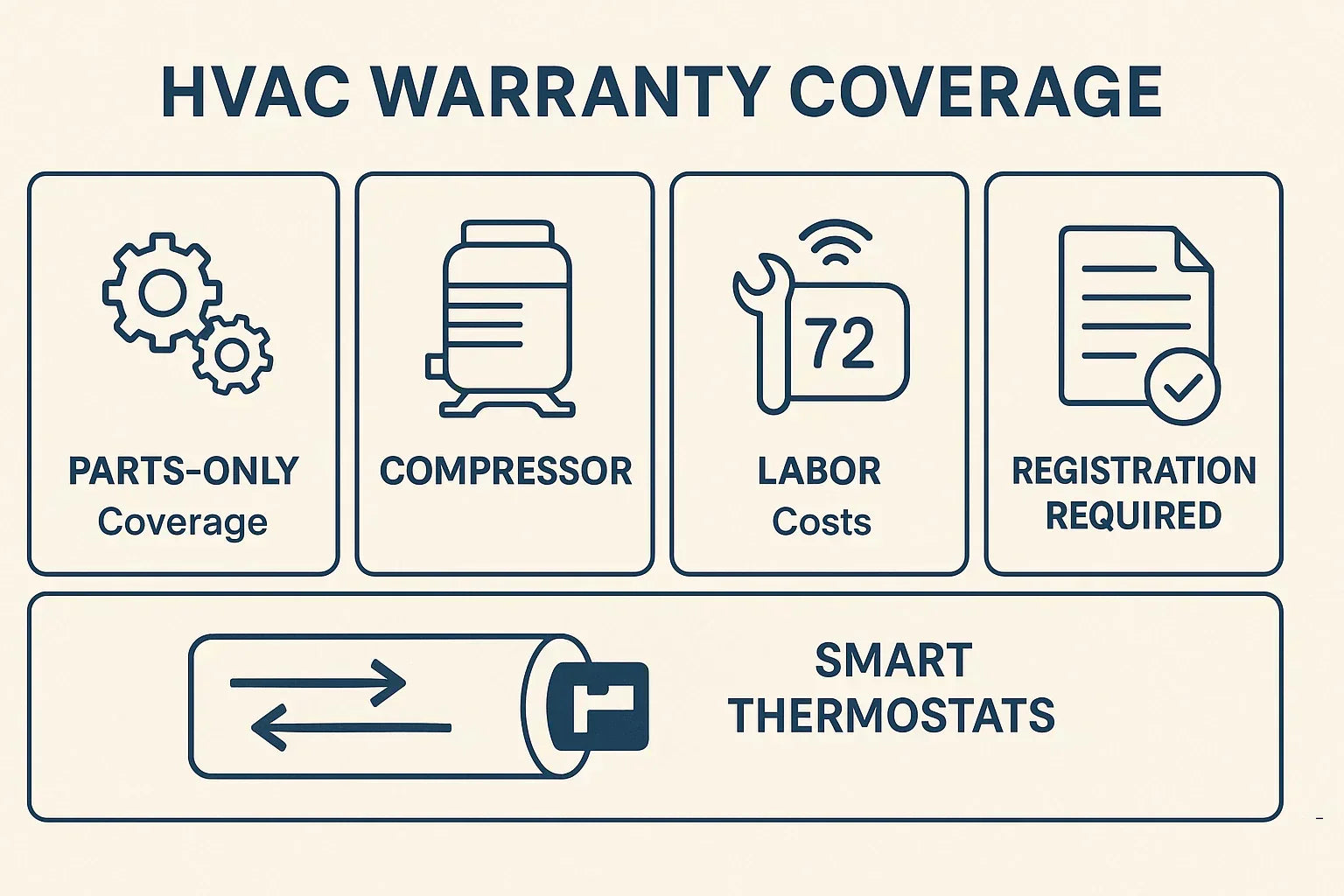When the SEER2 efficiency standard took effect in 2023, it didn’t just change how systems are rated — it reshaped how manufacturers handle warranties.
Many homeowners don’t realize this, but your HVAC warranty may hinge on how your system was installed, whether it meets SEER2 requirements, and even how it’s maintained. And with higher-efficiency systems using more advanced components, proper installation and registration are more critical than ever.
Here’s what you need to know before buying, installing, or registering your SEER2-rated HVAC system — so your warranty protects the investment you’re making.
What’s Typically Covered Under HVAC Warranties
A standard HVAC warranty usually falls into a few buckets:
🛠️ Parts-Only Coverage
Most manufacturers offer 5 to 10 years of coverage on parts like capacitors, relays, and coils. SEER2 units, especially high-efficiency models, often include variable-speed motors and smart sensors — which are more expensive to replace and more sensitive to improper setup.
🔄 Compressor Coverage
The compressor is the heart of your system. For SEER2-rated units — especially 17+ SEER2 — the compressor may come with longer coverage (10–12 years), but only if properly installed and registered.
👷 Labor (Sometimes Optional)
Most warranties don’t include labor costs unless a separate extended warranty is purchased through the manufacturer or installing contractor.
🔌 Smart Thermostats & ECM Motors
Components like ECM blower motors or factory-installed smart thermostats may fall under a different coverage period — or may be voided entirely if paired with incompatible systems.
📘 Lennox – Warranty Coverage Breakdown
How SEER2 Affects Warranty Eligibility
This is where things get serious: you can void your warranty by accident — especially with high-efficiency SEER2 equipment. Here's how that happens.
1. Improper Installation
If your system isn’t installed per manufacturer specs (like airflow or static pressure tolerances), the warranty may be nullified. SEER2 units are tested at higher static pressures, which means they’re more sensitive to duct design and airflow.
📘 What is SEER2 and Why It Matters
2. Mismatched System Components
Pairing a SEER2 outdoor unit with a non-rated indoor coil or air handler can void the AHRI-certified match, which affects both performance and warranty eligibility.
📘 AHRI Directory – Verify HVAC Equipment Matches
3. Failure to Register the Unit
Most manufacturers require registration within 60 to 90 days of installation to qualify for full coverage. Miss the window, and you might lose up to 5 years of warranty.
Extended Warranties for SEER2 Equipment: Are They Worth It?
This is one of the most common questions I get: Should I pay extra for an extended HVAC warranty on a SEER2 system?
✅ When Extended Warranties Make Sense:
-
You're installing a variable-speed or inverter-driven system
-
You live in a hot or cold climate where your system will run year-round
-
You plan to stay in your home long-term
-
You don’t have a local contractor offering long-term labor guarantees
Some brands like Trane, Carrier, and Rheem offer extended options through dealers or third parties — but be sure to read the fine print. Some only cover parts, while others include labor.
📘 Carolina Comfort Air – HVAC Extended Labor Warranty Benefits
How to Protect Your Warranty (and Your Wallet)
📝 Register Your System Right Away
Visit the manufacturer’s site and complete the registration form. Have your serial numbers, install date, and contractor info ready.
📂 Keep Documentation
Keep a digital folder with:
-
Purchase receipt and contractor invoice
-
AHRI certificate of system match
-
Maintenance records (filters, tune-ups, repairs)
🛠 Schedule Preventive Maintenance
Most warranties require annual professional maintenance. Skipping tune-ups can void your claim if a covered part fails.
📘 Energy Star – HVAC Maintenance Tips
🔧 Use Approved Parts Only
If you DIY a repair or let a non-licensed tech install off-brand parts, you’re playing with fire — and you may lose your warranty entirely.
Final Thoughts from Alex Lane
Warranties aren’t just paperwork — they’re your safety net when something goes wrong. But today’s SEER2-rated systems require more care, more precision, and more documentation than ever before.
Here’s what I recommend:
-
Get it installed right. Hire a licensed, SEER2-knowledgeable HVAC contractor.
-
Register it on time. Don’t wait — do it the day it’s installed.
-
Maintain it annually. And keep those records in a safe place.
Because whether you’re buying a 14.3 SEER2 unit or a high-efficiency 20 SEER2 system, your warranty should protect the investment — not become a loophole.
🔗 Curious how your climate impacts payback time on high-SEER2 systems?
👉 How Regional Climate Affects SEER2 Payback Time
Alex Lane
Your Home Comfort Advocate







